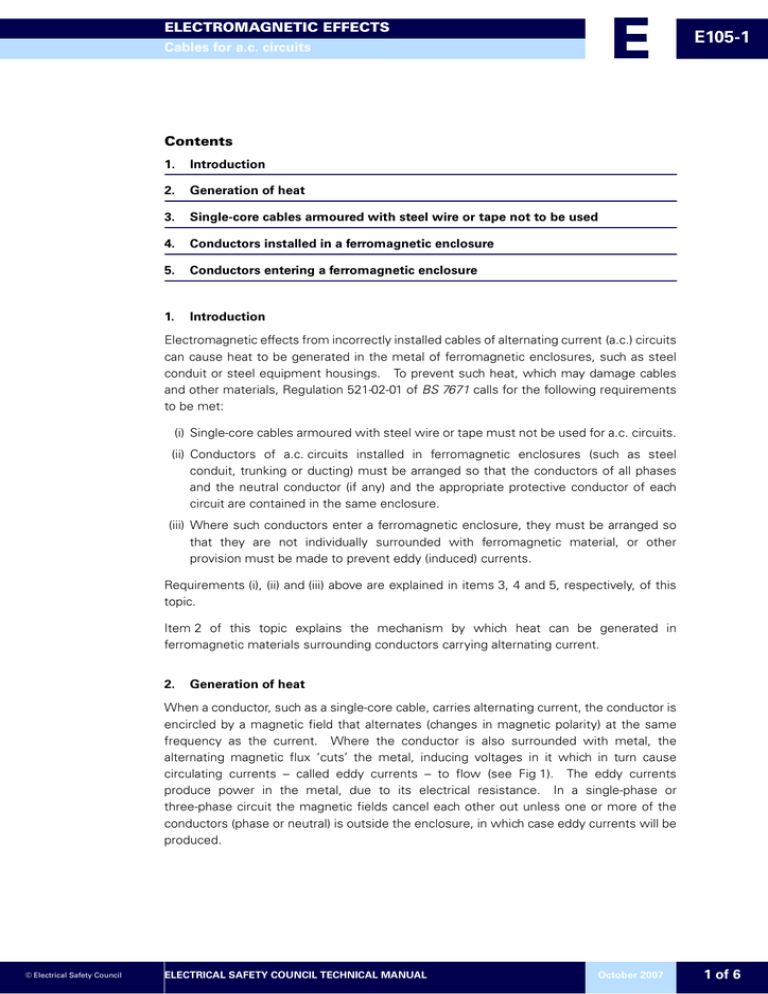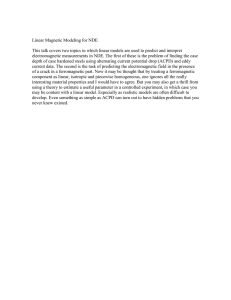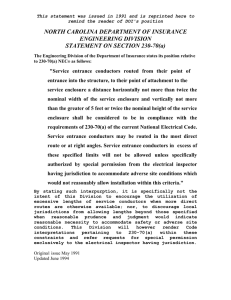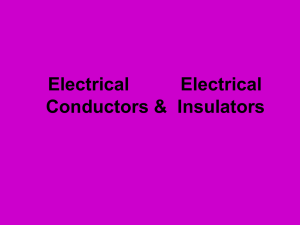E E105-1 - Voltimum
advertisement

E ELECTROMAGNETIC EFFECTS Cables for a.c. circuits E105-1 ELECTROMAGNETIC EFFECTS - Cables for a.c. circuits Contents 1. Introduction 2. Generation of heat 3. Single-core cables armoured with steel wire or tape not to be used 4. Conductors installed in a ferromagnetic enclosure 5. Conductors entering a ferromagnetic enclosure 1. Introduction Electromagnetic effects from incorrectly installed cables of alternating current (a.c.) circuits can cause heat to be generated in the metal of ferromagnetic enclosures, such as steel conduit or steel equipment housings. To prevent such heat, which may damage cables and other materials, Regulation 521-02-01 of BS 7671 calls for the following requirements to be met: (i) Single-core cables armoured with steel wire or tape must not be used for a.c. circuits. (ii) Conductors of a.c. circuits installed in ferromagnetic enclosures (such as steel conduit, trunking or ducting) must be arranged so that the conductors of all phases and the neutral conductor (if any) and the appropriate protective conductor of each circuit are contained in the same enclosure. (iii) Where such conductors enter a ferromagnetic enclosure, they must be arranged so that they are not individually surrounded with ferromagnetic material, or other provision must be made to prevent eddy (induced) currents. Requirements (i), (ii) and (iii) above are explained in items 3, 4 and 5, respectively, of this topic. Item 2 of this topic explains the mechanism by which heat can be generated in ferromagnetic materials surrounding conductors carrying alternating current. 2. Generation of heat When a conductor, such as a single-core cable, carries alternating current, the conductor is encircled by a magnetic field that alternates (changes in magnetic polarity) at the same frequency as the current. Where the conductor is also surrounded with metal, the alternating magnetic flux ‘cuts’ the metal, inducing voltages in it which in turn cause circulating currents – called eddy currents – to flow (see Fig 1). The eddy currents produce power in the metal, due to its electrical resistance. In a single-phase or three-phase circuit the magnetic fields cancel each other out unless one or more of the conductors (phase or neutral) is outside the enclosure, in which case eddy currents will be produced. © Electrical Safety Council ELECTRICAL SAFETY COUNCIL TECHNICAL MANUAL October 2007 1 of 6 ELECTROMAGNETIC EFFECTS Cables for a.c. circuits E E105-1 Where metal surrounding a conductor (or some of the conductors) of an a.c. circuit is ferromagnetic, such as iron or steel, the power dissipated in the metal as a result of the eddy currents can cause the metal to heat up. This is because, with a ferromagnetic metal, the flux density of the alternating magnetic field is greater than with a non-ferromagnetic metal, such as aluminium or copper, due to the high relative permeabilities of ferromagnetic metals. Hence the eddy currents, and consequently the power dissipated in the metal, are greater if the metal is ferromagnetic, making the metal liable to heat up. If the metal is non-ferromagnetic, no noticeable heating of it due to eddy currents will occur. Metal surrounding a single conductor carrying alternating current Warning! This arrangement is not permitted by BS 7671 where the metal surrounding the conductor is ferromagnetic (such as steel) Metal surrounding conductor (eg tube) Alternating magnetic field Conductor Typical eddy current loop Alternating current Fig 1 Note: Eddy currents (as shown in Fig 1) are still produced if the metal surrounds some, but not all, of the conductors of an a.c. circuit, as the magnetic fields surrounding the conductors do not then cancel each other out. Eddy current heating of metal does not occur if it surrounds all the conductors of an a.c. circuit collectively, even if the metal is ferromagnetic. This is because, in such circumstances, the overall sum of the magnetic fields encircling the conductors is equal to zero. In this context, it should be noted that BS 7671 regards the circuit protective conductor as one of the circuit conductors (unless formed by the enclosing metal, such as conduit), as it has to carry current in certain circumstances. © Electrical Safety Council ELECTRICAL SAFETY COUNCIL TECHNICAL MANUAL October 2007 2 of 6 E ELECTROMAGNETIC EFFECTS Cables for a.c. circuits 3. E105-1 Single-core cables armoured with steel wire or tape not to be used Regulation 521-02-01 does not permit the use of single-core cables armoured with steel wire or tape for a.c. circuits. Such use would automatically result in conductors being individually surrounded in ferromagnetic material, with the consequent risk of the armouring being heated up as a result of eddy currents. 4. Conductors installed in a ferromagnetic enclosure Where a ferromagnetic enclosure, such as steel conduit, trunking or ducting, is used to contain conductors of a.c. circuits, Regulation 521-02-01 requires the conductors of all phases and the neutral conductor (if any) and the appropriate protective conductor of each circuit to be contained in the same enclosure. This is so that the overall sum of the magnetic fields encircling the contained conductors when carrying a.c. current will be zero, so there will be no resulting eddy current heating of the enclosure. The rule may appear to be broken in the case of a steel conduit or other ferromagnetic enclosure taking the cables to a lighting switch position. However, so long as all the associated unswitched and switched phase conductors are contained in the same enclosure, as shown in Fig 2, the magnetic fields add up to zero, and hence no eddy currents (or heat) are produced in the metal of the enclosure. Lighting switch wiring contained in a ferromagnetic enclosure Neutral Ferromagnetic enclosure (eg steel conduit) Phase Luminaires All associated unswitched and switched phase conductors contained in the same enclosure Lighting switch (2 - gang) Fig 2 © Electrical Safety Council ELECTRICAL SAFETY COUNCIL TECHNICAL MANUAL October 2007 3 of 6 E ELECTROMAGNETIC EFFECTS Cables for a.c. circuits 5. E105-1 Conductors entering a ferromagnetic enclosure Where conductors of an a.c. circuit enter a ferromagnetic enclosure, Regulation 521-02-01 requires that one of the following two arrangements is provided: • The conductors are arranged so that they are not individually surrounded with ferromagnetic material. An example of this is given in Fig 3, which shows cables supplying an item of switchgear having a ferromagnetic enclosure, entering the enclosure from steel trunking though a single entry hole. • Some other provision is made to prevent eddy currents. For example, the conductors may enter the enclosure through separate holes of a plate made of either non-ferromagnetic metal (such as aluminium, brass or some types of stainless steel *) or non-metallic material † (see Fig 4), or through separate holes of a ferromagnetic plate (such as steel) having a slot which joins the holes to each other, so that they effectively form a single hole (see Fig 5). It should be remembered that where a plate containing such a slot is used to protect against contact with live parts (protection against direct contact), the width of the slot must be small enough to meet the requirements of Regulation Group 412-03 ‡. Cables all passing through the same entry hole Item of switchgear having a ferromagnetic enclosure L1 L2 L3 N Steel trunking Fig 3 * Most stainless steels are not ferromagnetic but some are. The application of a magnet will determine whether or not a particular sample is ferromagnetic. † The material should be selected to meet the requirements of Regulation 526-03-02 for enclosure of connections. ‡ To satisfy Regulation Group 412-03, the width of a slot must be less than 1 mm (IP4X) if in a readily accessible top surface, or not more than 12 mm (IP2X or IPXXB) if in any other surface. © Electrical Safety Council ELECTRICAL SAFETY COUNCIL TECHNICAL MANUAL October 2007 4 of 6 E ELECTROMAGNETIC EFFECTS Cables for a.c. circuits E105-1 Cables passing through separate holes of a non-ferromagnetic metal plate or a non-metallic plate Conductors (sheathed with non-ferromagnetic material) Plate of non-ferromagnetic metal or non-metallic material Ferromagnetic enclosure N L3 L2 L1 Fig 4 Cables passing through separate holes of a ferromagnetic metal plate having a slot Conductors (sheathed with non-ferromagnetic material) Slotted ferromagnetic plate L1 N L3 L2 Ferromagnetic enclosure Slot joining holes Fig 5 © Electrical Safety Council ELECTRICAL SAFETY COUNCIL TECHNICAL MANUAL October 2007 5 of 6 ELECTROMAGNETIC EFFECTS Cables for a.c. circuits E E105-1 Topics referred to in this text: None Topics not referred to in this text, which are related and may be of interest: None listed BS 7671 (Requirements for electrical installations) Some of the most important requirements are found in: Cables for a.c. circuits – electromagnetic effects © Electrical Safety Council ELECTRICAL SAFETY COUNCIL TECHNICAL MANUAL 521-02 October 2007 6 of 6




